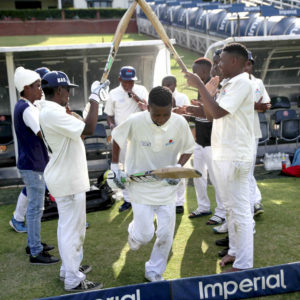The limits of a Wanderers without a crowd
Watching the second Test match between South Africa and India from inside the hallowed environs of the Bull Ring was a discomfiting cricketing experience that will hopefully change soon.
Author:
7 January 2022

Test cricket made a triumphant return to Johannesburg in the first week of January. In four gritty days, the South Africans fought their way back from being humbled at the hands of a sublime Indian attack at Centurion to level the three-match series going into a Cape Town decider.
The Wanderers pitch was a marvel. Wickets fell regularly and runs were hard-fought. When they came, they brought all the delight of a Flake chocolate at the end of a vanilla ice cream. Temba Bavuma’s on-drive off Jasprit Bumrah, which took South Africa to 150 in the 61st over of their second innings, was perhaps the best of the lot.
On day four, the heavens that try in vain each summer to cleanse Johannesburg opened up in a steady grey downpour that rendered most of the day a strained, lethargic wait. But once the rain stopped late in the afternoon, the Protea top order dragged the match back in an explosive final session.
In short, the game had everything that the always erudite Wanderers crowd would have appreciated. In the stadium’s storied history, it should go down as a tragedy that a match of this calibre went unappreciated by applause.
Related article:
The South Africans owe their victory largely to a typically dogged second innings rearguard from captain Dean Elgar, and a spell of Kagiso Rabada malevolence just before lunch on the third day that looked as close to unplayable as the Wanderers has seen in recent memory.
The previous day, Rabada’s usually fluid action had been laden with an effort that is simply not there when he is at his world-beating best. His deliveries were laboured, slow and missing their length. In the 31st over of India’s second innings, however, somewhere in the middle of the third day, Aiden Markram dropped a catch off Rabada’s bowling. Rabada appeared outwardly angry at the misstep, and it drove him on through 11 brilliant deliveries in which he felled three key Indian batsmen – Cheteshwar Pujara, Ajinkya Rahane and Rishabh Pant – at the cost of just seven runs.
Elgar, who was never fully comfortable outside his off stump, where Mohammed Shami in particular forced him into a million small decisions when he would have prefered only a few, was – as he often is – the victim before he was the hero. In one of what felt like countless body blows, Bumrah hit Elgar flush on the side of the helmet with a delivery that had the sound of a thick T-bone being dropped on a kitchen counter.
The exquisitely menacing delivery came at the end of another 15 ambled steps before Bumrah’s customarily compact run-up. The leader of the Indian bowling unit is mechanical. Not in the oily sense, but in the sense of a miracle motor engine you might find enshrined at the Smithsonian museum – something indispensable to the story of human progress. His movements are efficient and economical. But above all, and even now, he is always new.
Related article:
Beyond the veteran efforts of Elgar and Rabada, there were some cricketing lessons for a South African side still lacking an identity. Marco Jansen, the lanky, deadpan bowling allrounder, who was the quickest of the South African bowlers, looks like a good prospect. The Wanderers’ pitch, however, papered over cracks in his delivery that Test batters will expose on flatter tracks.
Keegan Petersen also suggested that the yawning chasm where South Africa’s middle order should be may yet be filled. Comfortably behind the ball most of the time, there were real moments of encouragement in the Paarl-born 28-year-old’s first innings, in which he was effective, if wobbly, when punching off his back foot. He dispatched Mohammed Siraj for equally handsome boundaries through the on then off side before guiding a Shami delivery safely through the gully to reach his maiden Test half-century. But the slim hopes of any South African supporters who caught their breath at the brief suggestion of a middle order renaissance were dashed three overs later when Petersen’s concentration lapsed in a needless drive against Shardul Thakur.
In the empty stands
All of this played out in a Wanderers that few will ever get to know. Diehard provincial supporters on a dull third morning session, maybe, or groundskeepers on some anonymous winter Wednesday. A Wanderers almost by night, as though we had been let inside the toy factory.
One may never otherwise notice the way the Unity Stand leaks gently after a night of rain, the drip-dripping giving the impression that it is drizzling lightly under the stadium’s roof. Or the small group of rosy-faced lovebirds that have shacked up in the same roof, the plovers and mynas in the outfield, or the grey herons and sacred ibises apparently waiting for an over to come to an end before flying over the ground near the close of play each day.
Without the crowd’s “oohs” and “aahs”, the fiction of cricket being a binary game of ascendency and descendance was also put to bed. In place of the spectacle came an endless piling up of small moments – a stream of consciousness dressed in whites – sometimes tingling, sometimes banal, always fraught. Small shots started to matter as much as big. Duanne Olivier digging Shami out late on the second day with the edge of his bat after surviving a vicious reverse-swinging LBW appeal earlier in the over, for instance, had all the grandeur of the few imperious cover drives Markram mustered in another two failed innings.
Related article:
The crowd is many things. At the Wanderers, it is a democratic quilt covering cricket’s shadier underbelly. During this Test, but for the workers checking vaccination cards and dishing ice cream, everybody at the Wanderers had to know somebody. And except for those lucky few who did – like so many Jonahs wide-eyed in the belly of a great whale – the stadium was empty. Unless you were a member of the game’s first and fourth estates, you weren’t getting in. And the respectable claps of cricket’s blazered elites were scant substitute for a Wanderers crowd that, under ordinary circumstances, according to one unerring cricket writer, is “a heaving, swirling mass” creating a noise that “rises and falls like a Highveld summer storm. Lightning, thunder, deluge; a cacophony of colour and sound.”
With its slowly changing banners featuring cricket’s corporate overlords, the Wanderers remained as quintessentially Joburg as three-metre-high walls or traffic light neuroses. This time, Johnny Walker dominated the ground, and television viewers can take heart in the knowledge that they were spared the whisky label’s regular and ridiculous “Keep Walking!” jingle, which sounded like it could have been written for a lollipop commercial from the early 2000s.
Outside the Wanderers, beyond the boundary, things looked worse and worse. The Test match began under the smoke of a burning National Assembly and unfolded along with a report on state capture detailing how far down the South African state has been plunged into the abyss.
In the quiet of a cricket colosseum we should all hope will hear bedlam again soon, then, it was a lesser-known mantra of the great Trinidadian cricket writer, CLR James – not to waste time figuring out which side is going to win, but to pick your side and do your best for it – that rang most true.



